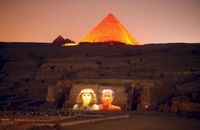The Giza Pyramids have recently captured the world's attention following claims by a research team from Italy and Scotland about the existence of an ancient city buried approximately 1,200 meters beneath them. According to a report by the British newspaper The Sun, the researchers assert they have made a groundbreaking discovery using radar technology that revealed an extensive underground metropolis featuring five mansions connected by communication tunnels, along with a multitude of other structures.
Professor Corrado Malanga, the leader of the project, described this finding as "a complete world" of structures lying beneath the iconic site. He noted that some of these concrete structures extend to depths of up to 650 meters, potentially dating back to the Helzouny era. This claim has sparked significant intrigue, but it has also raised eyebrows among experts in the field.
Critics of the research, including Professor Lawrence Conyers from the University of Denver, who specializes in radar technology and archaeology, have expressed skepticism about the findings. Conyers stated that current radar technologies are incapable of detecting any structures at such depths, labeling the assertions as "a major exaggeration." This skepticism highlights the ongoing debate within the archaeological community regarding the validity of such claims.
Adding to the skepticism, Dr. Zahi Hawass, the former Minister of Antiquities in Egypt, categorically denied the researchers' assertions. He pointed out that the Supreme Council of Antiquities has not issued any permits for research within the Khufu pyramid, one of the three Giza pyramids. Hawass further explained that the foundation of the pyramid is carved from solid rock to a depth of eight meters, and no structures or foundations have been documented beneath it according to scientific studies.
The Giza pyramids—Khufu, Khafre, and Menkaure—were constructed approximately 4,500 years ago on a rocky plateau west of the Nile River. The largest of these, the Khufu pyramid, stands at an impressive height of 480 feet. The middle pyramid belongs to Khafre, while the southern pyramid is dedicated to Menkaure. These monumental structures have long been subjects of fascination and research, drawing tourists and scholars alike.
Despite the skepticism surrounding the recent claims, some experts believe this discovery could significantly elevate Egypt’s profile in the archaeological world. Laila Abd Al-Latif, a prominent figure in the field, suggested that this finding might serve as a turning point in the understanding of ancient Egyptian history. She indicated that upcoming research could unveil new secrets that have remained hidden until now, potentially reshaping our comprehension of Egypt’s past.
As the debate continues, the implications of such discoveries could attract a wave of global interest in Egypt’s archaeological heritage. Scholars and experts from various countries, both Arab and foreign, are expected to flock to the Giza pyramids to document this event and closely follow its developments. The excitement surrounding the potential unveiling of new historical insights is palpable, with many eager to witness what further investigations might reveal.
While the claims of an ancient city beneath the Giza Pyramids are met with skepticism, they also serve as a reminder of the enduring allure of Egypt’s ancient civilization. The pyramids have captivated the imaginations of countless individuals over the centuries, and each new discovery—whether validated or contested—adds to the rich tapestry of history that surrounds these monumental structures.
In conclusion, the recent claims regarding the existence of a hidden city beneath the Giza pyramids have sparked a lively debate among experts in archaeology and radar technology. While some hail the discovery as revolutionary, others urge caution, emphasizing the need for rigorous scientific validation. As researchers continue to explore the depths of Egypt’s past, the world watches with bated breath, eager to learn what secrets the sands of time may yet reveal.






